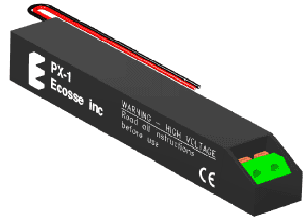Introducing the PX-1 Expendable Fireset

Improved perforating safety should be offered as:
(a) an expensive option.
(b) a standard item.
The need for radio silence during explosives operations is:
(a) very costly to eliminate.
(b) a thing of the past.
During perforating jobs, electric welding and helicopter flights should be:
(a) suspended.
(b) continued as normal. |
Typical PX-1 output pulse
PX-1 = Pulse eXpendable1
EBW = Exploding Bridge Wire
EFI = Exploding Foil Initiator |
Of Course, you'd like to complete all the above statements with option (b), and now you can. Designed and certified to be immune to the stray voltages and RF environment typically found on well sites and offshore platforms, the PX-1 from Ecosse is a low-cost, high performance EBW/EFI fireset that allows normal oilfield operations to continue while perforating and other completion services are being performed.
Radios stay on; communication links are unbroken; helicopter flights continue; construction work is uninterrupted; production is unaffected; the use of sensitive primary explosives is avoided. All of these advantages are available with the PX-1 fireset from Ecosse.
Designed primarily for oilfield applications, the PX-1 generates the high-current pulse needed to initiate EBW and EFI detonators. With features that complement the safety characteristics of these detonators. compact dimensions that allow it to be used in gun systems down to 1-3/8in OD, a low cost that allows it to be discarded after one use, and a temperature rating greater than any other system on the market, the PX-1 is a flexible and affordable tool that will immediately improve your bottom line.
"The PX-1 firing tool safety features operated as intended to prevent accidental firing due to the effects of RF interference and stray voltages as might typically be found in the oilfield environment. These electrical safety features also successfully provided protection against a direct lightning strike to the wireline. The PX-1 Firing System, therefore, meets its design requirements by allowing perforating operations to be conducted without interrupting radio communications, welding operations, cathodic protection systems, or other potential sources of stray voltages."
Quote from certification report by Orion International Technologies Inc
What are EBW and EFI Detonators?
EBW and EFI detonators were originally developed for use in military applications. They need a very fast rising, high-current pulse for successful initiation, such as the output provided by the Ecosse PX-1.
Unlike conventional hot-wire and hot-resistor detonators normally used in oilfield perforating operations, EBW and EFI detonators do not contain sensitive primary explosives such as lead azide.
Why use EBW/EFI?
The greatest advantage of EBW and EFI detonators for oilfield use is the fact that they are extremely insensitive to accidental initiation. They are effectively immune to the Radio Frequency (RF) sources and stray voltages found on well sites and offshore platforms, which means radio transmitter, electric welding and cathodic protection equipment need not be turned off during perforating and other wireline explosives operations. |
Which type to use?
EBWs are generally easier to initiate than EFIs, which makes them more tolerant of imperfect wiring methods and allows them to be fired over relatively long lengths of wire. EBWs are also less expensive than EFls, typically costing about the same as conventional hot-wire detonators. Oilfield EBWs are available using RDX and CP explosives, giving them useful temperature ratings of 163°C (325°F) and 204ºC (400ºF) respectively.
EFls are more difficult to initiate than EBWs, and they are typically 2-4 times more expensive. However, they use high-temperature explosives such as HNS, which means they can be used at higher temperatures than EBWs.
More Information
Contact Ecosse for a copy of the certification report, or to learn more about the PX-1. For information on EBW and EFI detonators, contact RISI. |
|
Specifications
|
Safety features (tested immune to)
|
negative DC: |
-600VDC |
|
positive DC: |
+150VDC |
|
AC: |
40Hz - 20kHz 600VAC
32kHz - 2MHz l00VAC |
|
RF interference: |
56kHz - 500MHz 50V/m
500MHz- lGHz l00V/m
lGHz- 1 8GHz 300V/m |
|
Electrostatic discharge: |
25kV 500pF 5kohm
30kV 400pF 250ohm |
|
Lightning strike: |
nearby 20kA l00m
direct strike 70kA / 280A |
|
|
Size (LxWxH): |
5in x 0.82in x 0.74in (<1.06in dia) |
|
Weight: |
75gm |
|
Temperature: |
-25°C to +225°C /2 hrs |
|
Input: |
200-230VDC ~ 160-260mA |
|
Output: |
5000V / >2000A / <250ns
Will fire EBWs through 10ft of twisted-pair wire, EFIs through 6in of twisted-pair wire |
|
Rated lifespan: |
1 x 1-sec test-fire into 100ohm load,
1 x ffill discharge into detonator |
| NOTES: All safety features were tested and certified at Sandia National Laboratories by Orion International Technologies Inc. All tests were done at ambient temperature, and all tests (apart from the lightning strikes) were repeated at 93°C - 121°C. |
|
To purchase PX-1 firesets or obtain a copy of the certification report, contact Spartek Systems at:
Spartek Systems
#1 Thevenaz Industrial Trail Sylvan Lake,
Alberta Canada,T4S 2J6
Tel: (403) 887-2443
[email protected]
To purchase RDX-based EBW and HNS-based EFI detonators, or to purchase PX-1 firesets, contact RISI at:
Teledyne RISI E-mail: [email protected] 